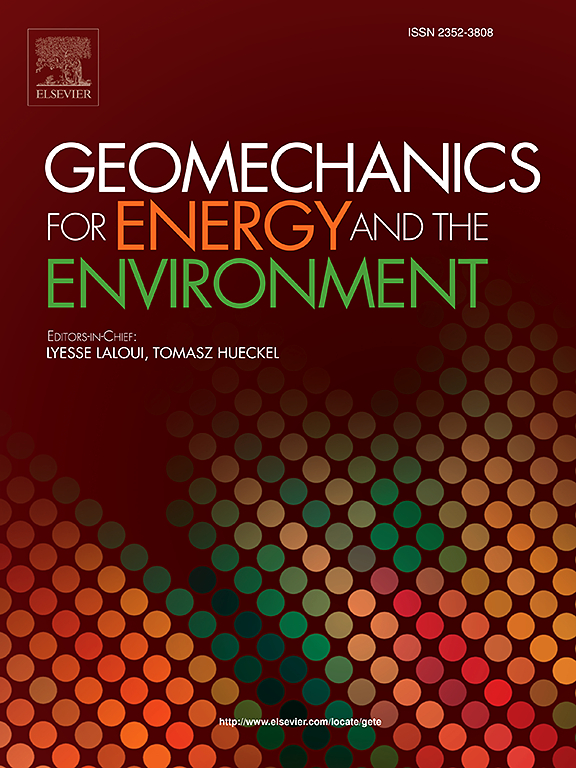Shape effect of shear box in large-scale direct shear test for soil-rock mixture
IF 3.7
2区 工程技术
Q3 ENERGY & FUELS
引用次数: 0
Abstract
The large-scale direct shear test is one of the simplest and most efficient methods for testing the shear strength parameters of soil-rock mixtures (S-RM), with shear boxes available in various shapes such as circular and rectangular. However, it remains unclear whether the shear box shape affects the accuracy of the results from large-scale direct shear tests. Therefore, this study uses a three-dimensional (3D) discrete element method to construct a numerical model for large-scale direct shear tests on S-RM, accounting for realistic rock block shapes. Subsequently, the reliability of this numerical model was validated by comparing it with results from large-scale direct shear tests laboratory. Next, the direct shear test results of the same S-RM were compared between circular and square shear boxes. The results indicate that the test results in the square shear box are more accurate. In the circular shear box, the test results approximate those in the square shear box, but their deformation is not a strict plane strain. Finally, the influence of the length-width ratio (L/W) of the shear box on results of large-scale direct shear tests on S-RM is discussed. Results show that as the L/W decreases, the interlocking effect between rock blocks strengthens, the number of force chains increases, and the shear band thickness decreases; the stress-strain curve transitions from strain-softening to strain-hardening; both cohesion and internal friction angle exhibit two distinct trends within the range before and after the L/W reaches 1:1. Thus, in large-scale direct shear tests of S-RM, square shear boxes with a L/W of 1:1 are preferred, followed by rectangular shear boxes with a L/W greater than 1:1, while shear boxes with a L/W less than 1:1 should be avoided.
土石混合体大尺度直剪试验中剪切箱形状效应研究
大型直剪试验是测试土石混合体抗剪强度参数最简单、最有效的方法之一,剪切箱有圆形和矩形等多种形状。然而,剪切箱的形状是否会影响大型直剪试验结果的准确性尚不清楚。因此,本研究采用三维(3D)离散元方法,在考虑真实岩块形状的情况下,构建S-RM大尺度直剪试验数值模型。通过与室内大型直剪试验结果的对比,验证了该数值模型的可靠性。接下来,比较了圆形和方形剪切箱对同一S-RM的直剪试验结果。结果表明,方形剪切箱的试验结果更为准确。在圆形剪切箱中,试验结果与方形剪切箱中的试验结果接近,但它们的变形不是严格的平面应变。最后,讨论了剪切箱长宽比(L/W)对S-RM大型直剪试验结果的影响。结果表明:随着L/W的减小,岩块间的联锁效应增强,力链数增加,剪切带厚度减小;应力-应变曲线由应变软化过渡到应变硬化;黏聚力和内摩擦角在L/W达到1:1前后表现出明显的变化趋势。因此,在S-RM大型直剪试验中,首选L/W为1:1的方形剪切箱,其次是L/W大于1:1的矩形剪切箱,而L/W小于1:1的剪切箱应避免使用。
本文章由计算机程序翻译,如有差异,请以英文原文为准。
求助全文
约1分钟内获得全文
求助全文
来源期刊

Geomechanics for Energy and the Environment
Earth and Planetary Sciences-Geotechnical Engineering and Engineering Geology
CiteScore
5.90
自引率
11.80%
发文量
87
期刊介绍:
The aim of the Journal is to publish research results of the highest quality and of lasting importance on the subject of geomechanics, with the focus on applications to geological energy production and storage, and the interaction of soils and rocks with the natural and engineered environment. Special attention is given to concepts and developments of new energy geotechnologies that comprise intrinsic mechanisms protecting the environment against a potential engineering induced damage, hence warranting sustainable usage of energy resources.
The scope of the journal is broad, including fundamental concepts in geomechanics and mechanics of porous media, the experiments and analysis of novel phenomena and applications. Of special interest are issues resulting from coupling of particular physics, chemistry and biology of external forcings, as well as of pore fluid/gas and minerals to the solid mechanics of the medium skeleton and pore fluid mechanics. The multi-scale and inter-scale interactions between the phenomena and the behavior representations are also of particular interest. Contributions to general theoretical approach to these issues, but of potential reference to geomechanics in its context of energy and the environment are also most welcome.
 求助内容:
求助内容: 应助结果提醒方式:
应助结果提醒方式:


